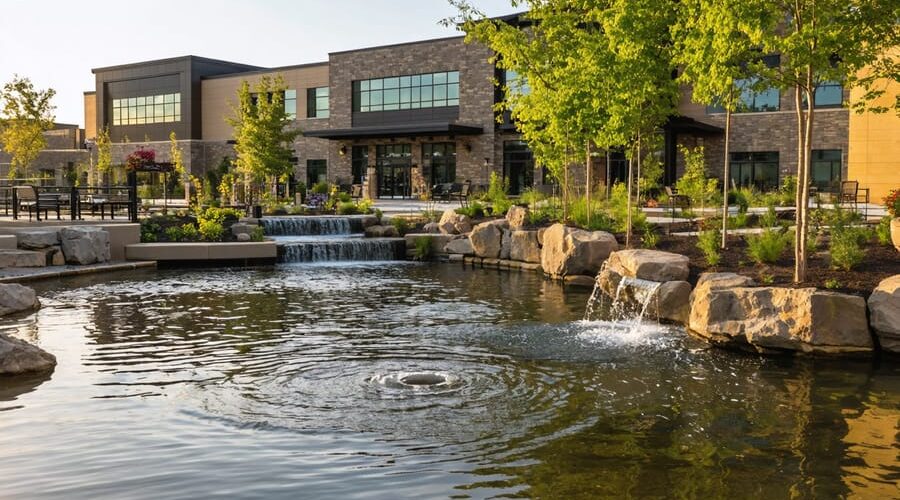
Essential Fire Safety for Your Water Garden and Assisted Living Property
Fire safety in assisted living facilities demands a comprehensive approach beyond standard protocols. Implementing essential fire protection strategies specifically designed for elderly residents requires meticulous attention to evacuation routes, staff training, and emergency response systems. With mobility-challenged residents and complex care requirements, traditional fire safety measures must be adapted and enhanced.
Regular fire drills tailored for residents with varying physical capabilities, strategically placed emergency call buttons, and clearly marked exit paths with wheelchair accessibility form the foundation of an effective safety system. Staff members need specialized training in assisting residents with different mobility levels during emergencies, while maintaining calm and organized evacuation procedures.
Modern fire suppression systems, including sprinklers and smoke detectors with both audible and visual alerts, must be integrated throughout the facility. These systems should be regularly tested and maintained to ensure reliability when seconds count.
Water Garden Features and Fire Risk Assessment
Electrical Equipment Safety
Proper maintenance and installation of electrical equipment is crucial for fire prevention in assisted living facilities. Following established electrical safety guidelines helps minimize fire risks and protect residents. All electrical installations should be performed by certified electricians who understand assisted living facility requirements.
Regular inspections of electrical equipment are essential. Check all power cords for fraying, damage, or wear at least monthly. Replace damaged cords immediately. Avoid overloading outlets with multiple devices or extension cords. Install surge protectors for sensitive medical equipment and ensure proper grounding of all electrical systems.
Lighting fixtures should be kept clear of flammable materials and dust. Clean light fixtures regularly and replace bulbs according to manufacturer specifications. Emergency lighting systems require monthly testing and battery replacement as needed.
For pumps and mechanical equipment, maintain proper ventilation to prevent overheating. Keep equipment rooms clean and free of clutter. Post clear signage indicating electrical hazards and emergency shut-off locations. Train staff on basic electrical safety procedures and emergency responses.

Surrounding Landscape Considerations
The landscape surrounding an assisted living facility plays a crucial role in fire safety management. Start by maintaining a 30-foot defensible space around all buildings, keeping this area free from dry vegetation and flammable materials. Regularly trim trees and shrubs, ensuring branches don’t extend over rooflines or near windows. Pay special attention to ornamental grasses and mulch beds, which can become significant fire hazards when dry.
For water features and garden areas, opt for fire-resistant plants like succulents, rockrose, or lavender. Avoid placing wooden structures, such as benches or pergolas, directly adjacent to buildings. When designing pathways around water features, use non-flammable materials like concrete or stone instead of wood chips or bark mulch.
Store garden equipment, fertilizers, and other potentially flammable materials in designated storage areas away from main buildings. Regular maintenance schedules should include removing dead vegetation, fallen leaves, and pine needles from water feature surroundings, especially during dry seasons. This comprehensive approach to landscape management significantly reduces fire risks while maintaining an attractive outdoor environment for residents.
Fire Safety Integration for Assisted Living Facilities
Accessibility Requirements
When designing water features in assisted living facilities, accessibility must seamlessly blend with safety requirements. All pathways around water gardens should be at least 36 inches wide to accommodate wheelchairs and walking aids, with non-slip surfaces that remain safe even when wet. Install handrails along walking paths near water features, ensuring they’re sturdy and positioned at the standard height of 34-38 inches.
Lighting plays a crucial role in both safety and accessibility. Install adequate pathway lighting that illuminates walking surfaces without creating glare, and consider motion-sensor lights for additional security during evening hours. Edge markers or contrasting colors along water feature boundaries help visually impaired residents identify transitions between paths and water areas.
Emergency shut-off controls for pumps and electrical systems must be easily accessible to staff and clearly marked. Position these controls at a height of 48 inches or lower to ensure accessibility from a seated position. Include multiple emergency call buttons or stations near water features, mounted at appropriate heights for both standing and seated use.
For maintenance access, incorporate wide gates and ramps where needed, with slopes not exceeding 1:12 ratio. Service panels and filtration systems should be positioned for easy access while remaining secure from resident tampering. Remember to maintain clear sight lines throughout the water garden area, allowing staff to monitor resident safety from multiple vantage points.

Emergency Access Points
Emergency access points are crucial components of effective emergency response planning in assisted living facilities. These designated areas must be clearly marked, easily accessible, and maintained clear of obstacles at all times. Key considerations include providing multiple entry points around the facility’s perimeter, ensuring each access point can accommodate large emergency vehicles like fire trucks and ambulances.
Every access point should feature well-lit signage visible both day and night, with clear directional indicators guiding emergency responders to critical areas. Driveways and pathways leading to these points must be at least 20 feet wide and strong enough to support heavy emergency vehicles. Regular maintenance of these areas, including snow removal in winter and vegetation management year-round, is essential.
Consider installing emergency knox boxes near main access points, containing facility maps, master keys, and access cards. This enables first responders to quickly enter any area of the facility during emergencies. Additionally, establish designated helicopter landing zones if your facility might require air medical services.
Remember to coordinate with local fire departments and emergency services to familiarize them with your access points during routine facility inspections. This proactive approach ensures smoother emergency response operations when every second counts.
Maintenance and Prevention Protocols
Seasonal Safety Checks
Regular safety checks throughout the year are essential for maintaining fire safety in assisted living facilities. Start each season with a comprehensive inspection schedule that addresses specific seasonal concerns.
In spring, focus on checking and cleaning HVAC systems as residents transition from heaters to air conditioning. Inspect all smoke detectors, replace batteries, and test emergency lighting systems. Review and update emergency evacuation routes as winter decorations come down.
Summer inspections should emphasize electrical system safety, particularly with increased air conditioning use. Check outdoor emergency gathering points, ensure they’re clearly marked, and verify that pathways remain unobstructed by seasonal landscaping.
Fall safety checks must include heating system inspections before first use. Clear fallen leaves from emergency exits and verify that weather-proof emergency lighting is functioning properly. Test all fire doors and smoke barriers for proper operation.
Winter requires special attention to heating equipment and holiday decoration safety. Inspect all electrical decorations, ensure proper spacing of space heaters, and check that snow removal plans keep emergency exits accessible.
Create a detailed checklist for each seasonal inspection, documenting completion dates and any issues found. Schedule follow-up maintenance immediately when problems are identified, and maintain records of all inspections for compliance purposes.

Staff Training Requirements
Maintaining fire safety in assisted living facilities requires comprehensive staff training, particularly for maintenance personnel who play a crucial role in prevention and emergency response. All maintenance staff must complete initial fire safety training upon hiring and participate in quarterly refresher courses to stay current with safety protocols.
Key training components include proper operation of fire suppression systems, regular inspection procedures for fire doors and emergency lighting, and maintenance of fire alarm systems. Staff must learn to identify potential fire hazards, such as faulty electrical wiring or blocked emergency exits, and understand the proper reporting procedures.
Maintenance personnel should also be trained in the proper storage and handling of flammable materials, including cleaning supplies and maintenance equipment. They must understand how to conduct regular safety checks of heating systems, electrical panels, and ventilation equipment.
Emergency response training is equally important, covering topics like shutoff procedures for utilities, operation of emergency generators, and assisting with evacuation procedures. Staff should practice these skills through regular fire drills and scenario-based training exercises.
Documentation of all training sessions, including attendance records and completion certificates, must be maintained to ensure compliance with state regulations and facility policies.
Fire safety in assisted living facilities requires constant vigilance and a comprehensive approach. Throughout this guide, we’ve explored essential aspects of maintaining a secure environment for residents, from proper emergency exit planning to regular equipment maintenance. Remember that even small oversights can have serious consequences, making it crucial to conduct thorough safety reviews on a scheduled basis.
Regular staff training, clear evacuation procedures, and well-maintained fire suppression systems form the foundation of an effective fire safety program. However, these elements must be continuously evaluated and updated to meet changing needs and regulations. Facility managers should establish a routine schedule for reviewing and updating safety protocols, checking equipment functionality, and conducting fire drills.
The safety of vulnerable residents depends on your commitment to maintaining these standards. Consider implementing a monthly checklist system to track inspections and maintenance tasks. By staying proactive and treating fire safety as an ongoing priority rather than a one-time effort, you can create a secure environment that gives residents and their families peace of mind while meeting all regulatory requirements.
